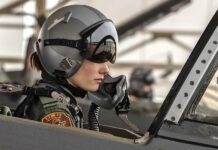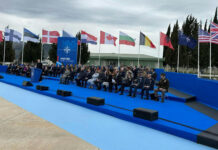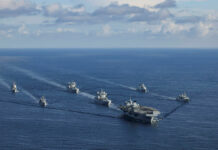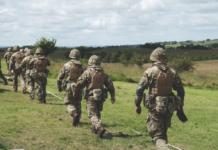To cope with the numerous new weapon systems that the Russian Army has fielded in recent years, the US Army has modernised its STRYKER vehicles.
On 9 May 2019, over 130 weapon systems rolled through Red Square in Moscow. NATO nations were warily watching as Russia showed off its latest military hardware. As T-14 ARMATA Tanks, BMPT-72 TERMINATOR Multipurpose tank support combat vehicles, T-15 Heavy Infantry Fighting Vehicles, and BTR-82A armoured personnel carriers drove by the reviewing stand they proved that Russia has been hard at work upgrading its mobile striking power. In a few short years, the Russians have developed and deployed a new generation of ground combat vehicles. Since the Russian annexation of Crimea in 2014, the threat of conflict in Eastern Europe has spurred NATO to upgrade and up-gun its own armoured forces. For the US Army, this means the fielding of the M1A2 SEPv3 main battle tank, the development of a new infantry fighting vehicle, and major improvements and new variants of the M1126 STRYKER.
The US Army’s M1126 STRYKER is produced by General Dynamics and provides the US Army with a number of rapidly deployed fire-brigades that can move by air or sea to deter opponents in Eastern Europe. The STRYKER is a versatile eight-wheeled, light-armoured infantry carrier that was first fielded in 2002. It is air transportable by C-130, C-117, and C5A aircraft. The C-5 can carry seven STRYKERs and the C-17 aircraft can carry four. A single US Navy SPEARHEAD class expeditionary fast transport (EPF) can carry a company of STRYKERs at 43 knots across moderate seas. The STRYKER cannot swim or ford rivers without expensive preparation. Depending on the configuration, the average cost of a new Stryker is about US$5M.
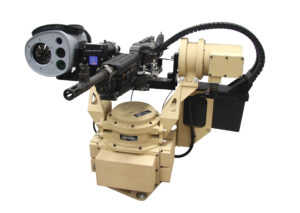
The STRYKER was highly successful in past combat operations in the urban centres of Iraq. In the less-urbanised terrain of Afghanistan, the STRYKER encountered more difficulties, but eventually proved itself again. The first STRYKER Brigade Combat Team (SBCT) sent to Afghanistan during the 2009 surge was the US Army’s 5th SBCT from Fort Lewis, Washington. The 5th SBCT deployed 350 STRYKERs and approximately 4,000 troops into combat in the densely vegetated valley of the Arghandab River northwest of the strategic Afghan city of Kandahar. This terrain was not ideal for STRYKERs and consisted of narrow trails, stone walls, and a patchwork of densely-planted orchards that made close-in ambushes the favourite tactic of the enemy. The Afghan insurgents successfully employed IEDs in this restricted terrain and in the first few months of combat operations, the 5th SBCT lost 21 STRYKERs to Improvised Explosive Devices (IEDS) with 21 Soldiers killed and as many wounded. According to the official US Army report on the fighting, “The worst incident occurred in October 2009 near the town of Jeleran where a massive 18,000-pound IED detonated under a STRYKER from Charlie Company killing 7 Soldiers.” These losses caused the Army to reassess the “V” shaped hull of the STRYKER and led to the development of an improved double-v hull (DVH) design to channel the blast force away from the vehicle and its occupants. In spite of the difficult opposition in the Arghandab fighting, the STRYKER proved an excellent combat vehicle in direct fire fights and the Remote Weapons Systems (RWS) was praised by the soldiers of the 5th SBCT. First Lieutenant Daniel Boirum, who fought in the Arghandab, noted: “The amount of firepower and infantry that [the carriers] can put on the table and the air-guard hatches and RWS make the STRYKER an unstoppable vehicle in a shootout.”
The STRYKER Family
The STRYKER currently has twelve configurations, with more variants soon to be added:
- M1126 Infantry Carrier Vehicle (ICV) acts as an infantry squad carrier, equipped with a PROTECTOR M151 RWS with .50-cal M2 machine gun, 7.62mm M240 machine gun, or Mk-19 automatic grenade launcher.
- M1127 Reconnaissance Vehicle (RV) is armed with the same PROTECTOR RWS and weapons options as the ICV.
- M1128 Mobile Gun System (MGS) is configured with a 105mm M68A2 rifled cannon. The MGS variant uses an automatic loader, can store eight rounds in the autoloader carousel, and can carry an additional 10 in a replenisher located at the rear of the vehicle. The gun has a firing rate of six rounds per minute and fires four different types of ammunition: the M900 kinetic energy penetrator to destroy armoured vehicles; the M456A2 high explosive anti-tank round to destroy thin-skinned vehicles and provide anti-personnel fragmentation; the M393A3 high explosive plastic round to destroy bunkers and emplacements; and M1040 canister shot for use against dismounted infantry.
- M1129 Mortar Carrier (MC-B) carries the Soltam Cardom RMS6L 120mm mortar which has a maximum effective range of 6.8 km. In addition, depending on the echelon (battalion or company mortars) the M1129 carries either an 81mm M252 mortar, or a 60mm M224 mortar, that must be displaced from the vehicle and used dismounted. The M1129 lacks the RWS and the commander’s station is instead ringed by a skate mount for an M240B machine gun.
- M1130 Command Vehicle (CV) integrates the C4ISR equipment required for unit commanders and is armed like the ICV.
- M1131 Fire Support Vehicle (FSV) provides artillery Fire Support Teams (FIST) with the systems that enhance surveillance, target acquisition, target identification, target designation, target tracking, and communications to deliver a “first round” fire-for-effect capability. The FSV is armed with the same RWS as the ICV.
- M1132 Engineering Squad Vehicle (ESV) has a mine-clearance blade, carries an engineer squad, and has the same RWS as the ICV.
- M1133 Medical Evacuation Vehicle (EV) does not have an RWS or mount weapons. The M1113 carries a medical aid team and can transport four litter patients or six ambulatory patients.
- M1134 Anti-Tank Guided Missile Carrier (ATGM) armed with two tube launchers for Tube-Launched, Optically Guided, Wire Controlled (TOW 2) anti-tank missiles.
- M1135 Nuclear Biological Chemical Reconnaissance Vehicle (NBCRV) has a chemical, biological, radiological and nuclear defence (CBRN) sensor suite that provides NBC situation awareness to STRYKER units and is armed with the same RWS as the ICV.
- M1296 Infantry Carrier Vehicle Dragoon (ICVD) is fitted with the Kongsberg designed unmanned 30mm cannon turret. The Dragoon is operated by two crewmen, a commander and driver, and carries a squad of 9 infantrymen.
- STRYKER A1 Interim Manoeuvre Short-Range Air Defence (IM-SHORAD) is a prototype STRYKER anti-aircraft variant, armed with 4 STINGER missiles on one side of the RWS, two HELLFIRE Missiles on the other, and a 30mm auto-cannon, coupled with a .50 calibre machine gun, in the middle. The first prototypes will be delivered in 2020, with up to 144, deployed in four battalions, by 2022.
The RWS platform used for STRYKER vehicles is the PROTECTOR RWS manufactured by Kongsberg of Norway. According to Kongsberg, the PROTECTOR is the most fielded RWS in the world with more than 20,000 units delivered and in use by militaries around the globe. The US Army’s version of the PROTECTOR is termed the Common Remotely Operated Weapon Station (CROWS). In an open competition, Kongsberg was awarded five-year contracts for the delivery of the PROTECTOR RWS CROWS II program in 2007 and again in 2012. CROWS II is a joint acquisition programme for weapon stations for all US Army vehicle programmes. A third five-year contract, signed in September 2018, will enable Kongsberg to continue providing CROWS to the US Army. CROWS have been placed on over 8,000 US Army vehicles and including the HMMWV, STRYKERs, and the M1A2 ABRAMS.

The CROWS provides for greater protection and increased weapon’s accuracy. It allows soldiers to operate from inside the protection of the vehicle without exposing the gunner to enemy fire. The gunner observes the target through a display screen that provides daylight and thermal options and controls the weapons by means of switches and a joystick. The sensors include stabilized precision options with a daylight video camera, thermal imager, and an eye-safe laser rangefinder. The key capability of the CROWS` aim and fire function, the Detached Line of Sight (DLOS) system, enables the gunner to keep his sights on a target, independent of the ballistic solution for the weapon and ammunition in use. The system’s camera can identify targets nearly 1.6 km away, track targets moving as fast as 56 kph, and has a 95% accuracy rate. The CROWS on STRYKER vehicles also include integrated smoke grenade launchers that can provide obscuration in directions independent of the vehicle’s orientation.
The Unmanned MCT-30 Turret
The US Army has worked with Kongsberg and other defence companies for the past several years to rapidly field a new 30mm cannon and unmanned turret to the 2nd Cavalry Regiment (2CR) stationed in Vilseck, Germany. The 2CR, also known as the 2nd Dragoons, is an active STRYKER equipped cavalry regiment of the US Army. The new STRYKER configuration fielded to the 2CR is designated as the M1296 STRYKER ICV DRAGOON. The DRAGOON has an unmanned MCT-30 turret that is produced by Kongsberg and an MK44 Bushmaster II 30mm auto-cannon designed by Alliant Techsystems of Northrop Grumman. The 30mm chain gun auto-cannon, can range out to 3,000 metres, holds 156 ready rounds in the turret (78/side) and has the capability to fire single shot or burst fire up to 200 rounds per minute. The 30mm cannon can fire either direct fire high-explosive, or airburst rounds. The MK310 Programmable Air Burst Munition rounds are programmed to detonate above the targets to defeat troops in trenches or in defilade, and can destroy trucks, drones and helicopters. The turret has a coaxially mounted M240 machine gun with 400 ready rounds of 7.62mm. While the addition of the turret added two tonnes to the vehicle’s weight, there has been no significant loss of performance.

There is little doubt that adapting the MCT-30 unmanned turret to the STRYKER has improved its lethality and effectiveness. “With this (referring to the 30mm auto-cannon), we’re seeing a shot group about the size of a basketball,” the senior NCO of the Army’s STRYKER programme, Sergeant First Class Nicholas Young, reported in a 2017 Army Public Affairs article. He praised the remotely operated cannon as it hit a target 1,800 metres away. “If I aim at something, I know I’m going to hit it and I’m going to do damage to it.” Soldiers of the 2CR noted that the only significant drawback of the new turret is the lack of a top hatch which prevents the crew from seeing outside. As more RWS are fielded to armoured vehicles, the need to mitigate this visibility issue may be solved with “transparent armour” technologies that add external cameras to the sides of the STRYKER coupled with an Augmented Reality (AR) capability for the crew to “see through” the armour and view outside the vehicle without opening a hatch. Another issue is finding an active protection system that will work for the STRYKER. Two systems were tested, IRON CURTAIN and TROPHY VPS (Vehicle Protection System), but both failed to work for the STRYKER.
The DRAGOON programme was rapidly executed to produce 81 vehicles for the 2nd CR in Europe due to an Urgent Operational Needs Statement issued in 2015. The DRAGOON is a flat-bottomed STRYKER and will not be fielded to the other SBCTs. In May 2019, the US Army picked five companies to compete to provide upgraded STRYKERs with improved lethality for the US Army’s STRYKER fleet. These five companies are Fabrication Inc., General Dynamics Land Systems, Kollsman Inc., Leonardo DRS, and Raytheon and Pratt & Miller Engineering. This upgraded STRYKER system will incorporate the improved STRYKER A1 DVH hull, improved RWS, and better situation awareness for the crew. The plan is to field a full SBCT improved STRYKERs by 2022.
Another CROWS addition to the STRYKER that is part of the rapid fielding process to the 2CR in Europe is the CROWS-J configuration. This RWS is an M153 CROWS II, manufactured by Kongsberg, which has been modified to launch fire-and-forget, infra-red homing, top-attack, FGM-148 JAVELIN ATGMs. The STRYKER crew can engage targets with the JAVELIN missile while under armour. The US Army has deployed 81 STRYKER CROWS-J to the 2CR thus equipping 50% of the vehicles in the rifle and scout platoons with an ATGM capability. Combined with the fielding of the 30mm cannon, the additional upgrades to the STRYKERs of the 2CR provide NATO with an enhanced force for reconnaissance and defensive operations. The US Army plans to equip three more STRYKER Brigade Combat Teams (SBCT) with both MCT-30 turret and CROWS-J capabilities in 2022.
Meeting NATO Obligations
NATO is facing a significant military threat that requires all NATO nations meet their treaty obligations. Some members, however, are years behind their pledge to fund, upgrade, and field adequate forces as part of the Alliance. With a few exceptions, NATO nations have not developed and deployed new tanks, infantry fighting vehicles, or light armoured vehicles, since the 1980s. The US has responded to the threat and is enhancing NATO’s ability to respond by up-gunning the STRYKERs of the 2d Dragoons with 30mm cannons and JAVELIN CROWS and plans to upgrade more SBCTs in the next two years. Eventually, all nine US Army SBCTs (seven Regular Army/two Army National Guard) will be upgraded. The US Army even plans to mount 50 kW-class Multi-Mission High Energy Laser (MMHEL) in the next four years to protect against unmanned aerial systems (UAS), helicopters, and incoming rocket, artillery, and mortar rounds. In addition, the US Army has recently added a company equipped with the Light Armoured Vehicle (LAV) 25A2s, armed with a 25mm cannon in a manned turret and borrowed from the US Marine Corps, to the 82d Airborne Division based at Fort Bragg, North Carolina. The LAV is lighter and smaller than the STRYKER but it is of the same general design and has a commonality of parts. While these lightly armoured LAVs are the 82d Airborne’s only organic armoured vehicles, they are better than no armoured vehicles at all.
Upgrading existing equipment and adding a dozen LAVs to the 82d Airborne Division, however, is merely a stopgap measure. STRYKERs and LAVs are no match for tanks and the combined arms threat posed by Russian forces in Eastern Europe. In a stab and grab operation by Russia into any of the Baltic nations that NATO has pledged to protect, how would NATO forces respond in time? As of December 2019, only nine of the 28 NATO countries spend at least 2% of their GDP on defence (US 3.42%, Bulgaria 3.25%, Greece 2.28%, the United Kingdom 2.14%, Estonia 2.14%, Romania 2.04%, Lithuania 2.03%, Latvia 2.01%, and Poland 2%). All agreed to spend at least 2%. To provide a convincing deterrent force that will prevent war, every NATO partner must not only meet its financial commitments but should also step up the effort to provide a rapid, heavily armoured, combined arms response to the Russian challenge. The US efforts to upgrade the STRYKER are an example to follow. Unless the threat is taken seriously, and all NATO nations act accordingly, the addition of the 30mm cannon and JAVELIN ATGM RWS to American STRYKER units may only be a forlorn hope.
John Antal is an expert on military affairs. He has published 14 books on military and leadership subjects and over 500 articles in military professional journals. He served 30 years as a soldier in the US Army, retiring as a Colonel, having commanded combat arms units from platoon to brigade.




